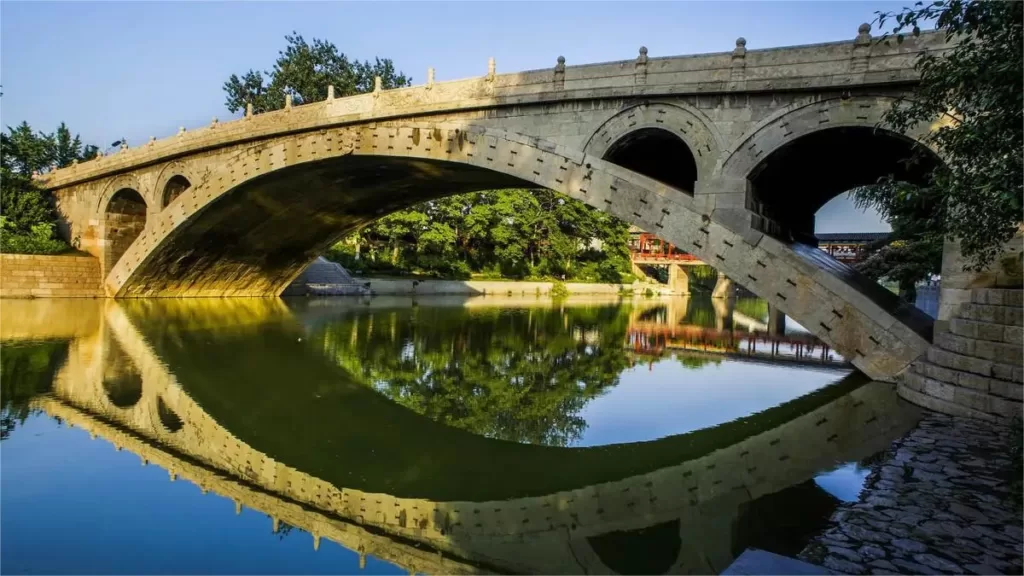Puente de Anji, Condado de Zhao - Ubicación, datos y puntos destacados


Spanning gracefully over the serene waters of the Jiao River in the southern region of Zhao County, ShijiazhuangProvincia de Hebei, stands a testament to ancient Chinese engineering and artistic brilliance – the Anji Bridge (安吉桥), also renowned as the Zhaozhou Bridge (赵州桥). This remarkable stone arch bridge, designed and constructed during the Sui Dynasty (581 – 618 CE) by the ingenious architect Li Chun, has etched its name in history for its grandeur, historical significance, and unrivaled architectural elegance. As a symbol of resilience against the test of time and the elements, Anji Bridge has inspired generations and continues to stand proudly as one of the world’s most exceptional architectural marvels.
Historical Origins
The origins of Anji Bridge date back to the golden era of the Sui Dynasty, when China was undergoing significant cultural and infrastructural transformations. Commissioned by the government, Li Chun, an accomplished architect of the time, was tasked with the challenge of creating a bridge that could withstand the elements and the relentless passage of time. The bridge was strategically located in Zhao County (near Bailin Temple), earning its original name, Zhaozhou Bridge, due to its location.
A Name That Echoes Through History
The Anji Bridge’s transformation from Zhaozhou Bridge to its current moniker, Anji Bridge, took place during the Northern Song Dynasty (960 – 1126 CE) under the reign of Zhezong Emperor. This renaming was a testament to the bridge’s enduring significance and the mark it left on the region’s history. Anji Bridge became a symbol of pride, an architectural icon that would be celebrated for generations to come.
Architectural Excellence
The Anji Bridge stands as a prime example of stone arch bridge engineering at its zenith. With a total length of 64 meters (211 feet), a remarkable span of 37 meters (121 feet), and an imposing height of 7 meters (24 feet), it was, and still is, a marvel of ancient engineering. Its single arch design was a groundbreaking achievement that set the standard for future bridge builders.
Influence on Bridge Design
The legacy of Anji Bridge extends far beyond its physical presence. This majestic structure has inspired countless architects and builders throughout history. Its style, characterized by simplicity and rigor, has been emulated in bridge design worldwide. The bridge’s enduring influence can be seen in various architectural works, demonstrating the enduring impact of this ancient masterpiece.
Exquisite Carvings and Decorations
Not only is the Anji Bridge a feat of engineering, but it is also adorned with intricate carvings and decorations. These delicate embellishments serve as a testament to the fusion of artistry and functionality that defines Chinese architecture. Each carving tells a story, embodying the culture, beliefs, and aesthetics of its time.
A History of Restoration
Over the centuries, the Anji Bridge has weathered the ravages of time, but it has not stood idly by. Historical records document several restoration efforts that took place in 782 (Tang Dynasty), 1066 (Song Dynasty), 1563 (Ming Dynasty), 1597 (Ming Dynasty), 1821 (Qing Dynasty), 1933 (Republic of China), and 1955 (People’s Republic of China). These meticulous repair and maintenance projects were carried out with great care, ensuring that the bridge’s essential structural integrity remained intact while replacing broken stones and enhancing its decorative features. These efforts are a testament to the enduring commitment to preserving this national treasure.
Video about Anji Bridge
Lugares históricos de Hebei, Atracciones de Shijiazhuang